
candle-vllm
Efficent platform for inference and serving local LLMs including an OpenAI compatible API server.
Stars: 329
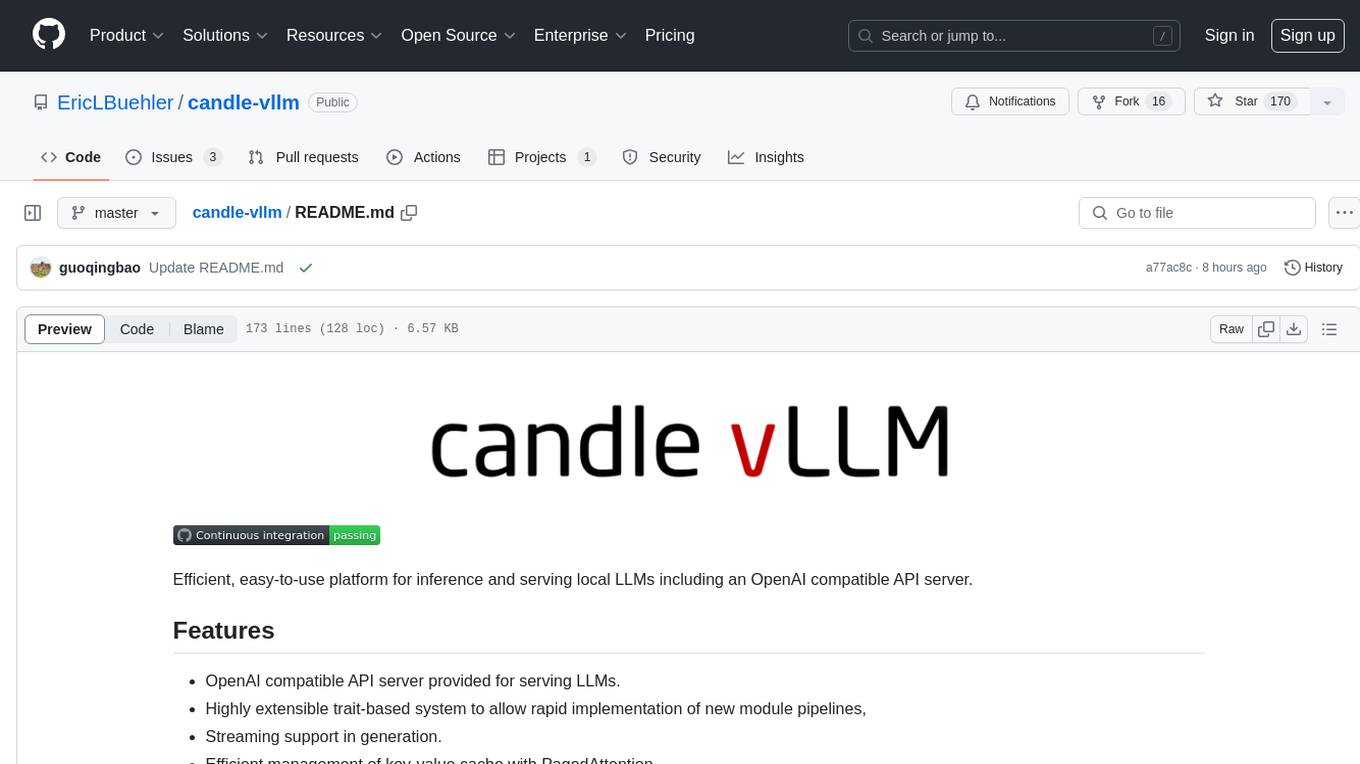
Candle-vllm is an efficient and easy-to-use platform designed for inference and serving local LLMs, featuring an OpenAI compatible API server. It offers a highly extensible trait-based system for rapid implementation of new module pipelines, streaming support in generation, efficient management of key-value cache with PagedAttention, and continuous batching. The tool supports chat serving for various models and provides a seamless experience for users to interact with LLMs through different interfaces.
README:
Efficient, easy-to-use platform for inference and serving local LLMs including an OpenAI compatible API server.
- OpenAI compatible API server provided for serving LLMs.
- Highly extensible trait-based system to allow rapid implementation of new module pipelines,
- Streaming support in generation.
- Efficient management of key-value cache with PagedAttention.
- Continuous batching.
-
In-situquantization (andIn-situmarlin format conversion) -
GPTQ/Marlinformat quantization (4-bit) - Support
Mac/Metaldevices - Support
Multi-GPUinference
Currently, candle-vllm supports chat serving for the following models.
| Model ID | Model Type | Supported | Speed (A100, BF16) |
Throughput (BF16, bs=16) |
Quantized (A100, Q4K or Marlin) |
Throughput (GTPQ/Marlin, bs=16) |
|---|---|---|---|---|---|---|
| #1 | LLAMA | ✅ | 65 tks/s (LLaMa3.1 8B) | 553 tks/s (LLaMa3.1 8B) | 75 tks/s (LLaMa3.1 8B), 115 tks/s (LLaMa3.1 8B, Marlin) | 968 tks/s (LLaMa3.1 8B) |
| #2 | Mistral | ✅ | 70 tks/s (7B) | 585 tks/s (7B) | 96 tks/s (7B), 115 tks/s (7B, Marlin) | 981 tks/s (7B) |
| #3 | Phi (v1, v1.5, v2) | ✅ | 97 tks/s (2.7B, F32+BF16) | TBD | - | TBD |
| #4 | Phi-3 (3.8B, 7B) | ✅ | 107 tks/s (3.8B) | 744 tks/s (3.8B) | 135 tks/s (3.8B) | TBD |
| #5 | Yi | ✅ | 75 tks/s (6B) | 566 tks/s (6B) | 105 tks/s (6B) | TBD |
| #6 | StableLM | ✅ | 99 tks/s (3B) | TBD | - | TBD |
| #7 | BigCode/StarCode | TBD | TBD | TBD | - | TBD |
| #8 | ChatGLM | TBD | TBD | TBD | - | TBD |
| #9 | QWen2 (1.8B, 7B) | ✅ | 148 tks/s (1.8B) | 784 tks/s (1.8B) | - | TBD |
| #10 | Google Gemma | ✅ | 130 tks/s (2B) | TBD | 73 tks/s (Gemma2-9B, Marlin) | 587 tks/s (Gemma2-9B) |
| #11 | DeepSeek-R1-Distill-QWen | TBD | TBD | TBD | 62 tks (QWen 14B) | TBD |
| #12 | DeepSeek-R1-Distill-LLaMa | TBD | TBD | TBD | 108 tks (LLaMa3.1 8B) | TBD |
| #13 | Moondream-2 (Multimodal LLM) | TBD | TBD | TBD | - | TBD |
| #14 | DeepSeek V2/V3/R1 | ✅ | TBD | TBD | - | TBD |
| #15 | QwQ-32B (GGUF) | ✅ | TBD | TBD | 36 tks/s (Q4K) | TBD |
https://github.com/user-attachments/assets/66b5b90e-e2ca-4f0b-82d7-99aa9f85568c
See this folder for some examples.
Install dependencies
curl --proto '=https' --tlsv1.2 -sSf https://sh.rustup.rs | sh
sudo apt install libssl-dev -y
sudo apt install pkg-config -y
git clone [email protected]:EricLBuehler/candle-vllm.git
cd candle-vllm
Run Uncompressed models
cargo run --release --features cuda -- --port 2000 --weight-path /home/DeepSeek-R1-Distill-Llama-8B/ llama3 --temperature 0. --penalty 1.0Note: assume model weights downloaded in folder /home/DeepSeek-R1-Distill-Llama-8B/
Run Marlin-compatible models, e.g., DeepSeek-R1-Distill-QWen-14B (Suggested, fastest approach)
#model format (4-bit GPTQ, 128-group, desc_act=False)
cargo run --release --features cuda -- --dtype bf16 --port 2000 --weight-path /home/DeepSeek-R1-Distill-Qwen-14B-GPTQ_4bit-128g qwen2 --quant gptq --temperature 0. --penalty 1.0
# If you don't have such model, you can convert Uncompressed model to Marlin-compatible format using the given script
python3 examples/convert_marlin.py --src /home/DeepSeek-R1-Distill-Qwen-14B/ --dst /home/DeepSeek-R1-Distill-Qwen-14B-GPTQ_4bit-128gNote: Candle-vLLM will repack the GPTQ model into Marlin format during model loading
Run Marlin-format models,
# If you have Marlin-format model, run it with (--quant marlin)
cargo run --release --features cuda -- --dtype bf16 --port 2000 --weight-path /home/DeepSeek-R1-Distill-Qwen-14B-GPTQ-Marlin/ qwen2 --quant marlin --penalty 1.0 --temperature 0.You may also run specific model using Huggingface model-id, e.g.,
cargo run --release --features cuda -- --port 2000 --model-id meta-llama/Llama-2-7b-chat-hf llamacargo run --release --features cuda -- --port 2000 --model-id avoroshilov/DeepSeek-R1-Distill-Qwen-14B-GPTQ_4bit-128g --quant gptq --penalty 1.0 --temperature 0.
Run QwQ-32B GGUF/GGML models on CUDA or Mac/Metal devices
cargo run --release --features cuda -- --port 2000 --model-id Qwen/QwQ-32B --dtype bf16 --weight-path ./ --weight-file qwq-32b-q4_k_m.gguf qwen2 --quant gguf --temperature 0. --penalty 1.0Run GGUF/GGML models on CUDA or Mac/Metal devices (assume gguf model downloaded in /Users/Downloads)
cargo run --release --features metal -- --port 2000 --model-id microsoft/Phi-3.5-mini-instruct --dtype bf16 --weight-path /Users/Downloads --weight-file Phi-3.5-mini-instruct-Q4_K_M.gguf phi3 --quant gguf --temperature 0. --penalty 1.0Note: dtype in gguf/ggml mode is used for kv cache and attention, you may choose f32 or bf16, while, f16 is not recommended.
Run DeepSeek MoE models
cargo run --release --features cuda -- --port 2000 --weight-path /home/DeepSeek-V2-Lite-Chat deep-seek --penalty 1.0 --temperature 0.
Run Multi-GPU inference with NCCL feature
cargo run --release --features cuda,nccl -- --port 2000 --device-ids "0,1" --weight-path /home/Meta-Llama-3.1-8B-Instruct/ llama3 --temperature 0. --penalty 1.0Run Multi-GPU inference with NCCL feature for quantized models
cargo run --release --features cuda,nccl -- --dtype bf16 --port 2000 --device-ids "0,1" --weight-path /home/Meta-Llama-3.1-8B-Instruct-GPTQ-INT4-Marlin/ llama3 --quant gptq --temperature 0. --penalty 1.0If you encountered problems under Multi-GPU settings, you may:
export NCCL_P2P_LEVEL=LOC # use local devices (multiple cards within a server, PCIE, etc.)
export NCCL_P2P_DISABLE=1 # disable p2p cause this feature can cause illegal memory access in certain environments
export NCCL_IB_DISABLE=1 # disable ibnet/infiniband (optional)Note: number of GPUs used must be aligned to 2^n (e.g., 2, 4, or 8).
Install API and chatbot dependencies (openai package is only used for local chat with candle-vllm)
python3 -m pip install openai rich clickChat with the mini chatbot
python3 examples/chat.pyChat demo on GPU (A100, LLaMa3.1 8B)
Chat demo on Apple M4 (Phi3 3.8B)
Install ChatUI and its dependencies:
git clone [email protected]:guoqingbao/candle-vllm-demo.git
cd candle-vllm-demo
apt install npm #install npm if needed
npm install n -g #update node js if needed
n stable #update node js if needed
npm i -g pnpm #install pnpm manager
pnpm install #install ChatUI dependencies
Launching the ChatUI:
pnpm run dev # run the ChatUI
ENOSPC: System limit for number of file watchers reached
echo fs.inotify.max_user_watches=524288 | sudo tee -a /etc/sysctl.conf && sudo sysctl -p
curl -X POST "http://127.0.0.1:2000/v1/chat/completions" \
-H "Content-Type: application/json" \
-H "Authorization: Bearer YOUR_API_KEY" \
-d '{
"model": "llama7b",
"messages": [
{"role": "user", "content": "Explain how to best learn Rust."}
],
"temperature": 0.7,
"max_tokens": 128,
"stop": {"Single":"</s>"}
}'Sample response:
{"id":"cmpl-53092967-c9cf-40e0-ae26-d7ac786d59e8","choices":[{"message":{"content":" Learning any programming language requires a combination of theory, practice, and dedication. Here are some steps and resources to help you learn Rust effectively:\n\n1. Start with the basics:\n\t* Understand the syntax and basic structure of Rust programs.\n\t* Learn about variables, data types, loops, and control structures.\n\t* Familiarize yourself with Rust's ownership system and borrowing mechanism.\n2. Read the Rust book:\n\t* The Rust book is an official resource that provides a comprehensive introduction to the language.\n\t* It covers topics such","role":"[INST]"},"finish_reason":"length","index":0,"logprobs":null}],"created":1718784498,"model":"llama7b","object":"chat.completion","usage":{"completion_tokens":129,"prompt_tokens":29,"total_tokens":158}}
In your terminal, install the openai Python package by running pip install openai. I use version 1.3.5.
Then, create a new Python file and write the following code:
import openai
openai.api_key = "EMPTY"
openai.base_url = "http://localhost:2000/v1/"
completion = openai.chat.completions.create(
model="llama",
messages=[
{
"role": "user",
"content": "Explain how to best learn Rust.",
},
],
max_tokens = 64,
)
print(completion.choices[0].message.content)After the candle-vllm service is running, run the Python script and enjoy efficient inference with an OpenAI compatible API server!
Install openai API first
python3 -m pip install openai
Run the benchmark test
python3 examples/benchmark.py --batch 16 --max_tokens 1024Refer to examples/benchmark.py
async def benchmark():
model = "mistral7b"
max_tokens = 1024
# 16 requests
prompts = ["Explain how to best learn Rust.",
"Please talk about deep learning in 100 words.",
"Do you know the capital city of China? Talk the details of you known.",
"Who is the best female actor in the world? Explain why.",
"How to dealing with depression?",
"How to make money in short time?",
"What is the future trend of large language model?",
"The famous tech companies in the world.",
"Explain how to best learn Rust.",
"Please talk about deep learning in 100 words.",
"Do you know the capital city of China? Talk the details of you known.",
"Who is the best female actor in the world? Explain why.",
"How to dealing with depression?",
"How to make money in short time?",
"What is the future trend of large language model?",
"The famous tech companies in the world."]
# send 16 chat requests at the same time
tasks: List[asyncio.Task] = []
for i in range(len(prompts)):
tasks.append(
asyncio.create_task(
chat_completion(model, max_tokens, prompts[i]))
)
# obtain the corresponding stream object for each request
outputs: List[Stream[ChatCompletionChunk]] = await asyncio.gather(*tasks)
# tasks for streaming chat responses
tasks_stream: List[asyncio.Task] = []
for i in range(len(outputs)):
tasks_stream.append(
asyncio.create_task(
stream_response(i, outputs[i]))
)
# gathering the response texts
outputs: List[(int, str)] = await asyncio.gather(*tasks_stream)
# print the results, you may find chat completion statistics in the backend server (i.e., candle-vllm)
for idx, output in outputs:
print("\n\n Response {}: \n\n {}".format(idx, output))
asyncio.run(benchmark())Candle-vllm now supports GPTQ (Marlin kernel), you may supply the quant (marlin) parameter if you have Marlin format quantized weights, such as:
cargo run --release --features cuda -- --port 2000 --dtype f16 --weight-path /home/Meta-Llama-3.1-8B-Instruct-GPTQ-INT4-Marlin/ llama3 --quant marlin --temperature 0. --penalty 1.
You may also use GPTQModel to transform a model to marlin-compatible format using the given script examples/convert_marlin.py.
Note: for using Marlin fast kernel, only 4-bit GPTQ quantization supported at the moment, and the input data type should be bf16 (--dtype bf16) or f16 (--dtype f16).
Candle-vllm now supports in-situ quantization, allowing the transformation of default weights (F32/F16/BF16) or 4-bit GPTQ weights into any GGML format (or marlin format) during model loading. This feature helps conserve GPU memory (or speedup inference performance through marlin kernel), making it more efficient for consumer-grade GPUs (e.g., RTX 4090). To use this feature, simply supply the quant parameter when running candle-vllm.
For unquantized models:
cargo run --release --features cuda -- --port 2000 --weight-path /home/Meta-Llama-3.1-8B-Instruct/ llama3 --quant q4k
For quantized 4-bit GPTQ model:
cargo run --release --features cuda -- --port 2000 --weight-path /home/mistral_7b-int4/ mistral --quant marlin
Options for quant parameters: ["q4_0", "q4_1", "q5_0", "q5_1", "q8_0", "q2k", "q3k","q4k","q5k","q6k", "marlin", "gguf", "ggml"]
Please note:
-
It may takes few minutes to load F32/F16/BF16 models into quantized;
-
Marlin format in-situ conversion only support 4-bit GPTQ (with
sym=True,groupsize=128or -1,desc_act=False); -
Marlin format only supported in CUDA platform.
For general configuration help, run cargo run -- --help.
For model-specific help, run cargo run --<MODE> --features <PLATFORM> -- --port 2000 <MODEL_TYPE> --help
For local model weights, run cargo run --release --features cuda -- --port 2000 --weight-path /home/llama2_7b/ llama, change the path when needed.
MODE=["debug", "release"]
PLATFORM=["cuda", "metal"]
MODEL_TYPE = ["llama", "llama3", "mistral", "phi2", "phi3", "qwen2", "gemma", "yi", "stable-lm", "deep-seek"]
WEIGHT_FILE_PATH = Corresponding weight path for the given model type
cargo run --release --features cuda -- --port 2000 --weight-path <WEIGHT_FILE_PATH> <MODEL_TYPE>
or
MODEL_ID = Huggingface model id
cargo run --release --features cuda -- --port 2000 --model-id <MODEL_ID> <MODEL_TYPE>
For kvcache configuration, set kvcache_mem_cpu and kvcache_mem_gpu, default 4GB CPU memory and 4GB GPU memory for kvcache.
For chat history settings, set record_conversation to true to let candle-vllm remember chat history. By default, candle-vllm does not record chat history; instead, the client sends both the messages and the contextual history to candle-vllm. If record_conversation is set to true, the client sends only new chat messages to candle-vllm, and candle-vllm is responsible for recording the previous chat messages. However, this approach requires per-session chat recording, which is not yet implemented, so the default approach record_conversation=false is recommended.
For chat streaming, the stream flag in chat request need to be set to True.
You may supply penalty and temperature to the model to prevent potential repetitions, for example:
cargo run --release --features cuda -- --port 2000 --weight-path /home/mistral_7b/ mistral --repeat-last-n 64 --penalty 1.1 --temperature 0.7
--max-gen-tokens parameter is used to control the maximum output tokens per chat response. The value will be set to 1/5 of max_sequence_len by default.
For consumer GPUs, it is suggested to run the models under GGML formats (or Marlin format), e.g.,
cargo run --release --features cuda -- --port 2000 --weight-path /home/Meta-Llama-3.1-8B-Instruct/ llama3 --quant q4k
where quant is one of ["q4_0", "q4_1", "q5_0", "q5_1", "q8_0", "q2k", "q3k","q4k","q5k","q6k", "marlin", "gguf", "ggml"].
Installing candle-vllm is as simple as the following steps. If you have any problems, please create an
issue.
The following features are planned to be implemented, but contributions are especially welcome:
- Sampling methods:
- Beam search (huggingface/candle#1319)
- More pipelines (from
candle-transformers)
- Python implementation:
vllm-project vllmpaper
For Tasks:
Click tags to check more tools for each tasksFor Jobs:
Alternative AI tools for candle-vllm
Similar Open Source Tools

candle-vllm
Candle-vllm is an efficient and easy-to-use platform designed for inference and serving local LLMs, featuring an OpenAI compatible API server. It offers a highly extensible trait-based system for rapid implementation of new module pipelines, streaming support in generation, efficient management of key-value cache with PagedAttention, and continuous batching. The tool supports chat serving for various models and provides a seamless experience for users to interact with LLMs through different interfaces.
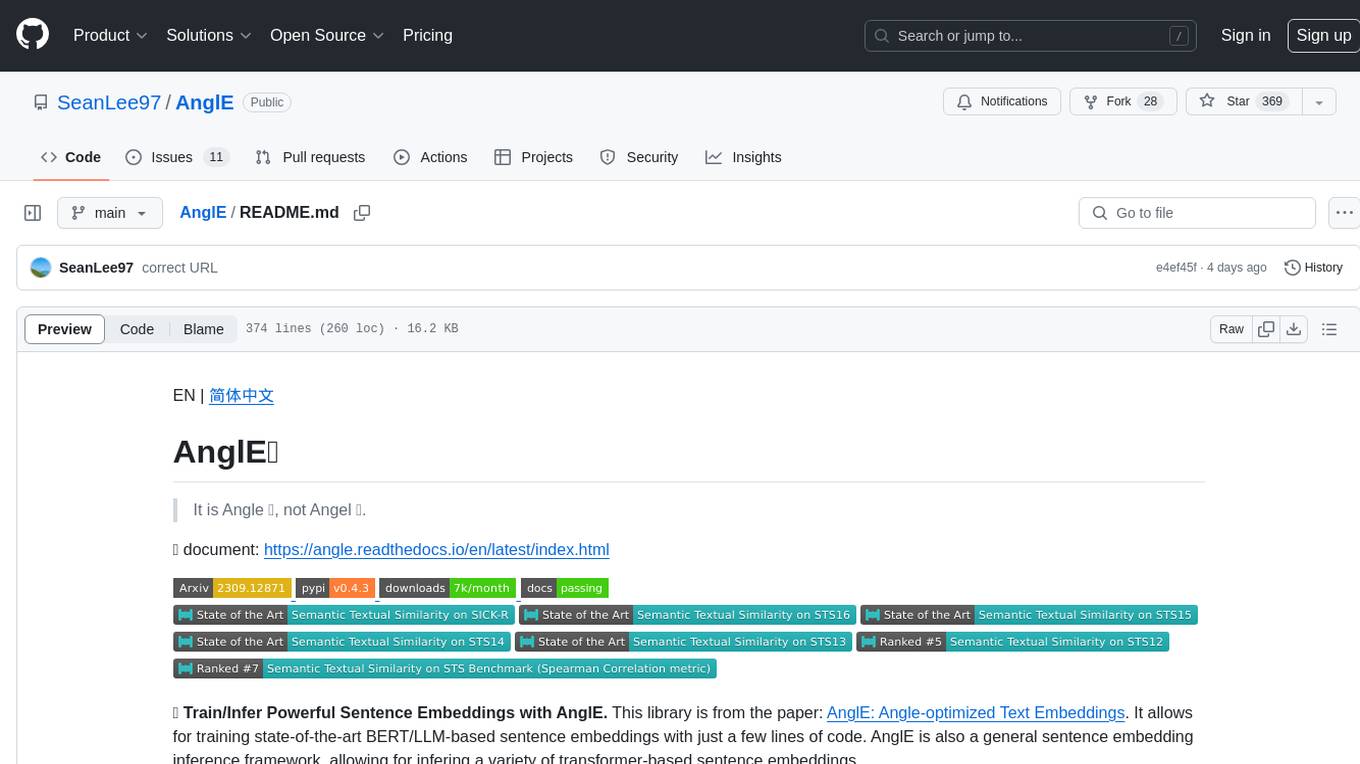
AnglE
AnglE is a library for training state-of-the-art BERT/LLM-based sentence embeddings with just a few lines of code. It also serves as a general sentence embedding inference framework, allowing for inferring a variety of transformer-based sentence embeddings. The library supports various loss functions such as AnglE loss, Contrastive loss, CoSENT loss, and Espresso loss. It provides backbones like BERT-based models, LLM-based models, and Bi-directional LLM-based models for training on single or multi-GPU setups. AnglE has achieved significant performance on various benchmarks and offers official pretrained models for both BERT-based and LLM-based models.
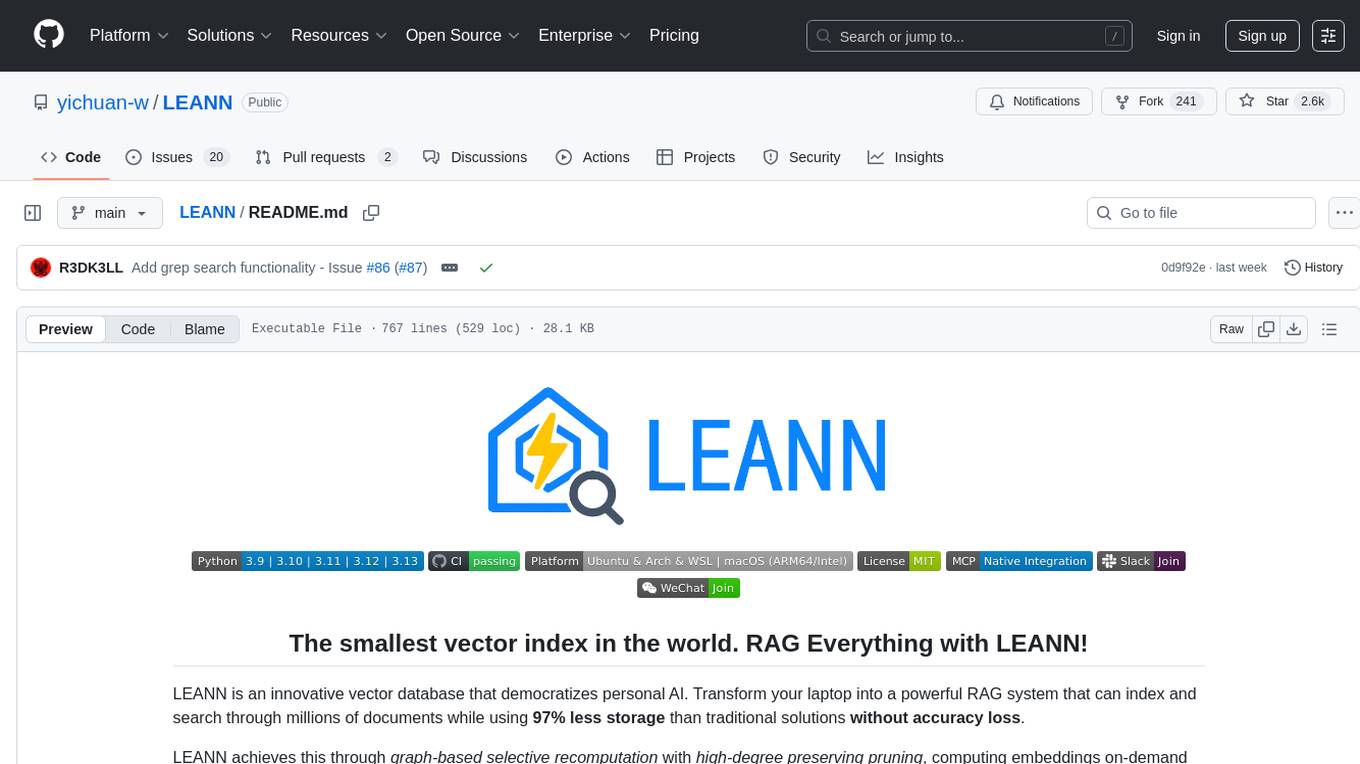
LEANN
LEANN is an innovative vector database that democratizes personal AI, transforming your laptop into a powerful RAG system that can index and search through millions of documents using 97% less storage than traditional solutions without accuracy loss. It achieves this through graph-based selective recomputation and high-degree preserving pruning, computing embeddings on-demand instead of storing them all. LEANN allows semantic search of file system, emails, browser history, chat history, codebase, or external knowledge bases on your laptop with zero cloud costs and complete privacy. It is a drop-in semantic search MCP service fully compatible with Claude Code, enabling intelligent retrieval without changing your workflow.
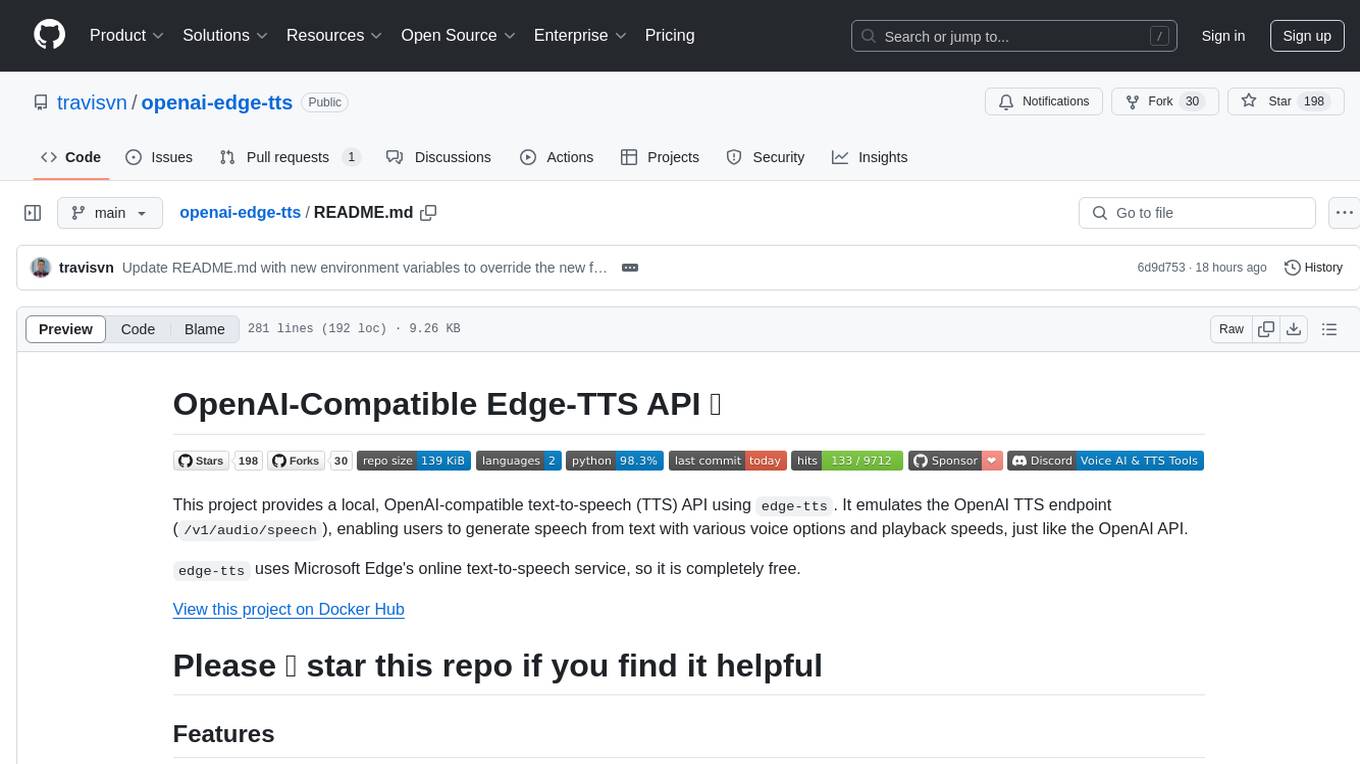
openai-edge-tts
This project provides a local, OpenAI-compatible text-to-speech (TTS) API using `edge-tts`. It emulates the OpenAI TTS endpoint (`/v1/audio/speech`), enabling users to generate speech from text with various voice options and playback speeds, just like the OpenAI API. `edge-tts` uses Microsoft Edge's online text-to-speech service, making it completely free. The project supports multiple audio formats, adjustable playback speed, and voice selection options, providing a flexible and customizable TTS solution for users.
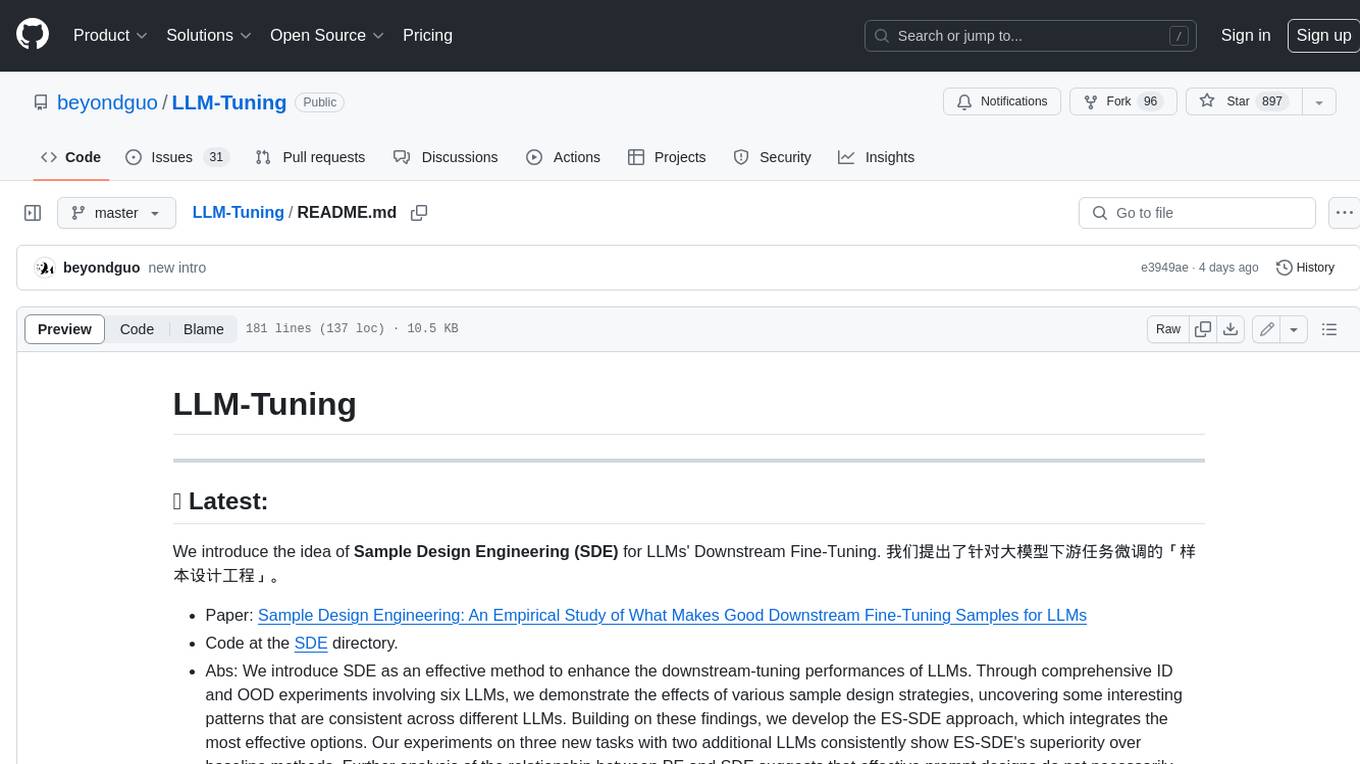
LLM-Tuning
LLM-Tuning is a collection of tools and resources for fine-tuning large language models (LLMs). It includes a library of pre-trained LoRA models, a set of tutorials and examples, and a community forum for discussion and support. LLM-Tuning makes it easy to fine-tune LLMs for a variety of tasks, including text classification, question answering, and dialogue generation. With LLM-Tuning, you can quickly and easily improve the performance of your LLMs on downstream tasks.
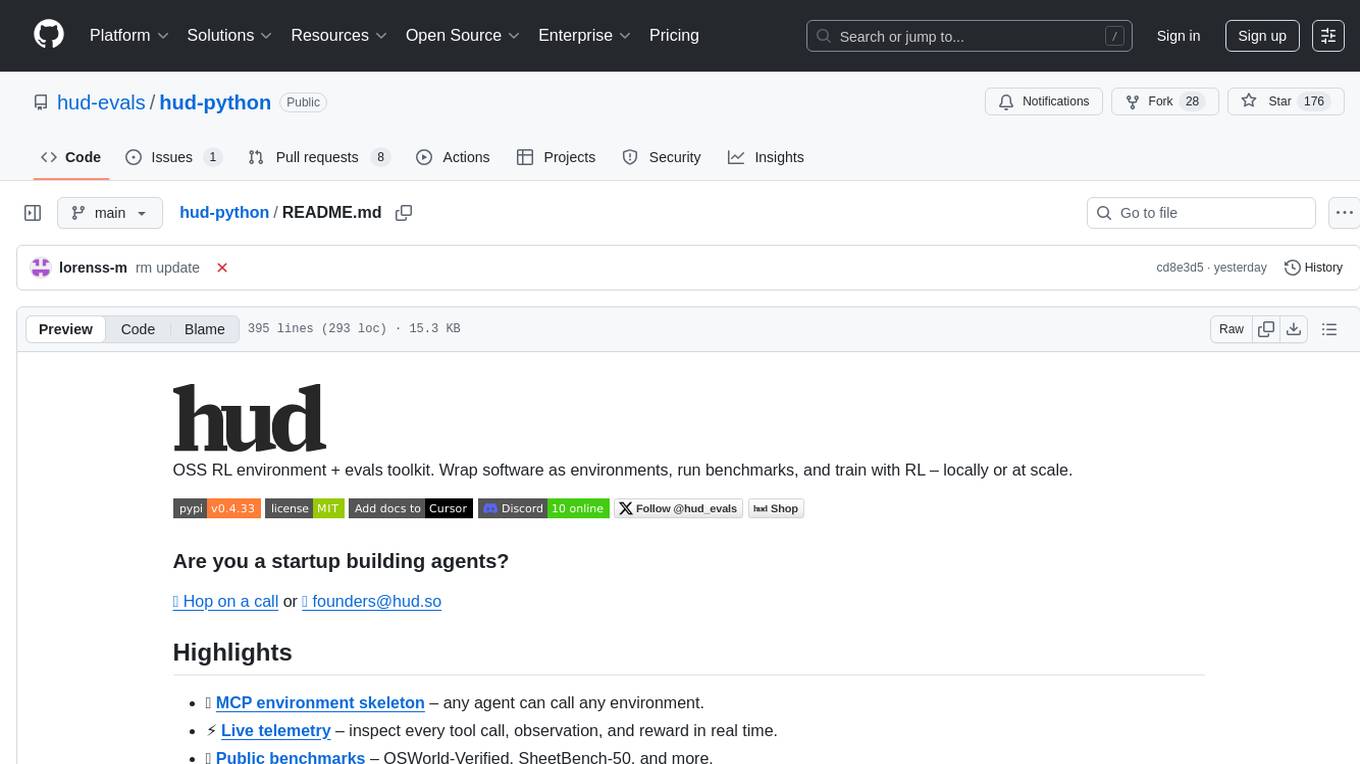
hud-python
hud-python is a Python library for creating interactive heads-up displays (HUDs) in video games. It provides a simple and flexible way to overlay information on the screen, such as player health, score, and notifications. The library is designed to be easy to use and customizable, allowing game developers to enhance the user experience by adding dynamic elements to their games. With hud-python, developers can create engaging HUDs that improve gameplay and provide important feedback to players.
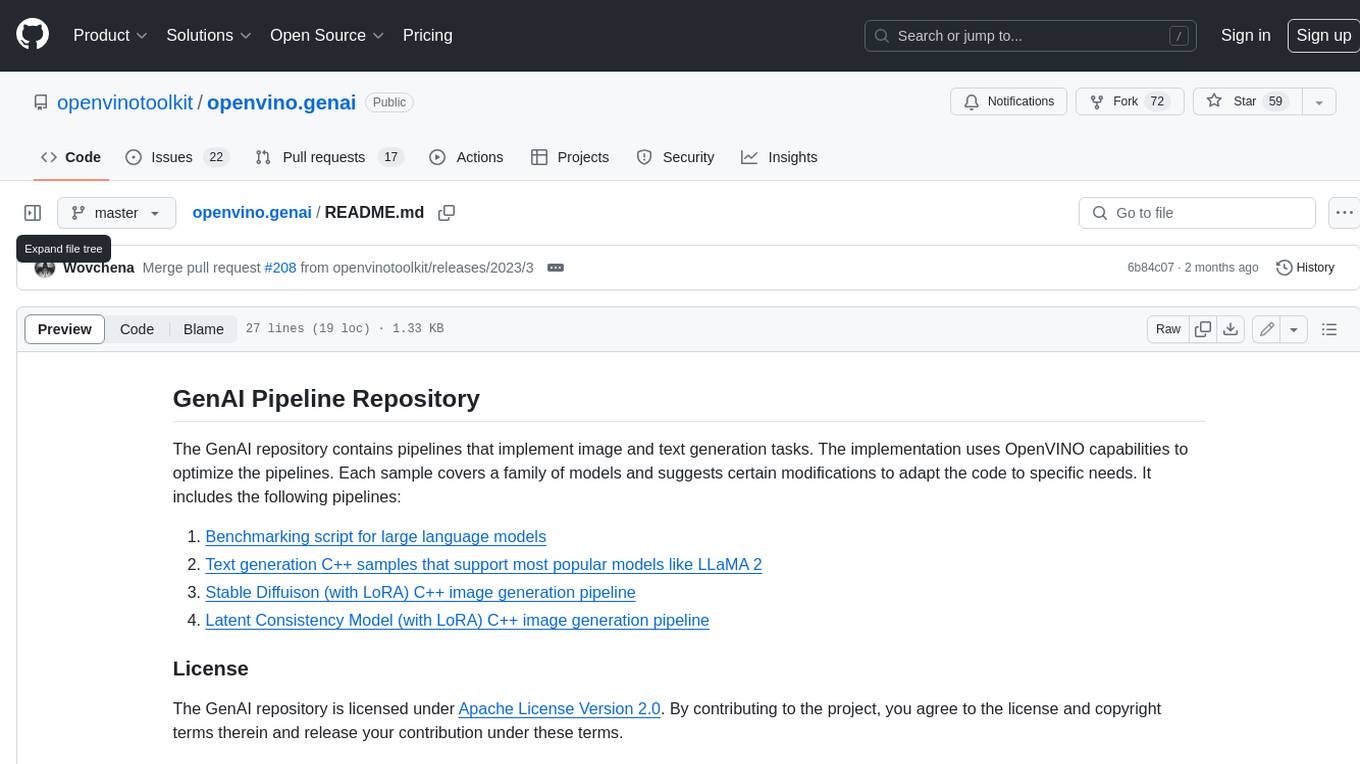
openvino.genai
The GenAI repository contains pipelines that implement image and text generation tasks. The implementation uses OpenVINO capabilities to optimize the pipelines. Each sample covers a family of models and suggests certain modifications to adapt the code to specific needs. It includes the following pipelines: 1. Benchmarking script for large language models 2. Text generation C++ samples that support most popular models like LLaMA 2 3. Stable Diffuison (with LoRA) C++ image generation pipeline 4. Latent Consistency Model (with LoRA) C++ image generation pipeline
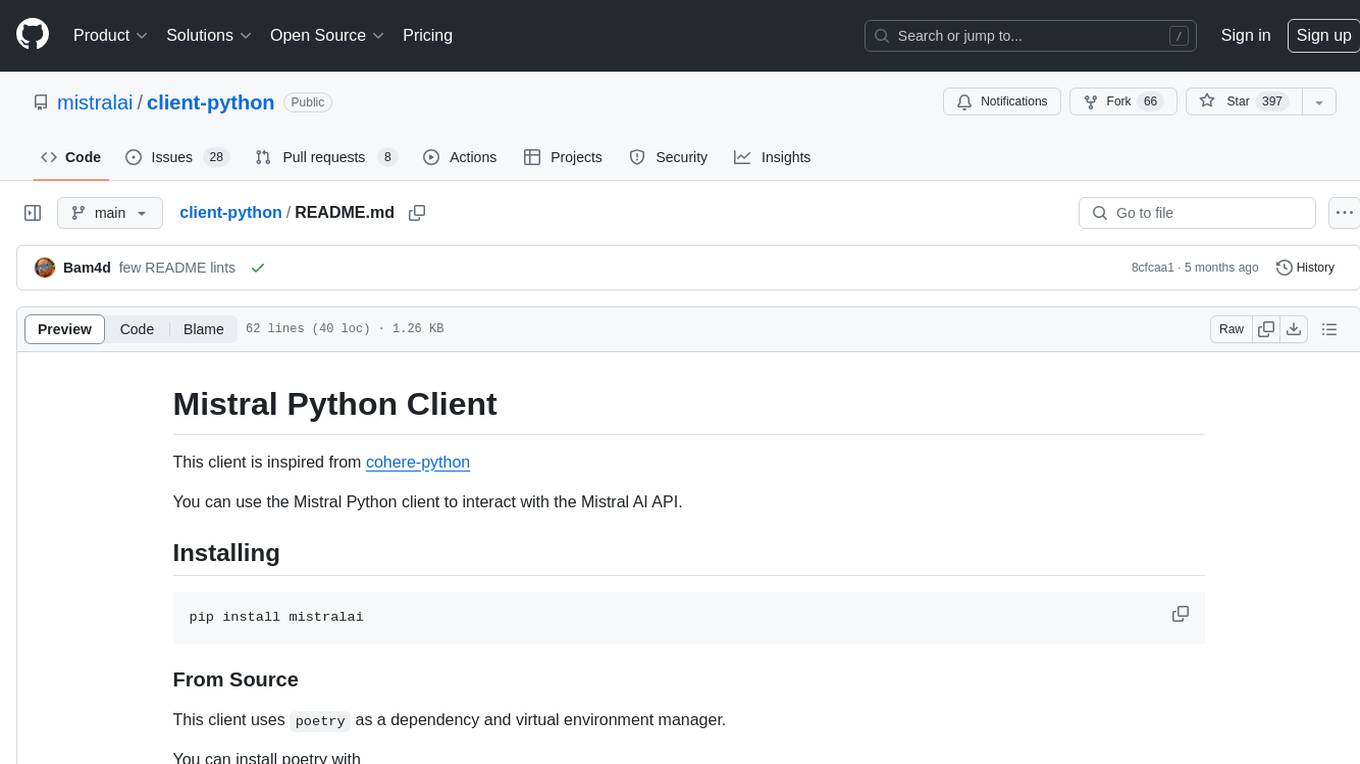
client-python
The Mistral Python Client is a tool inspired by cohere-python that allows users to interact with the Mistral AI API. It provides functionalities to access and utilize the AI capabilities offered by Mistral. Users can easily install the client using pip and manage dependencies using poetry. The client includes examples demonstrating how to use the API for various tasks, such as chat interactions. To get started, users need to obtain a Mistral API Key and set it as an environment variable. Overall, the Mistral Python Client simplifies the integration of Mistral AI services into Python applications.
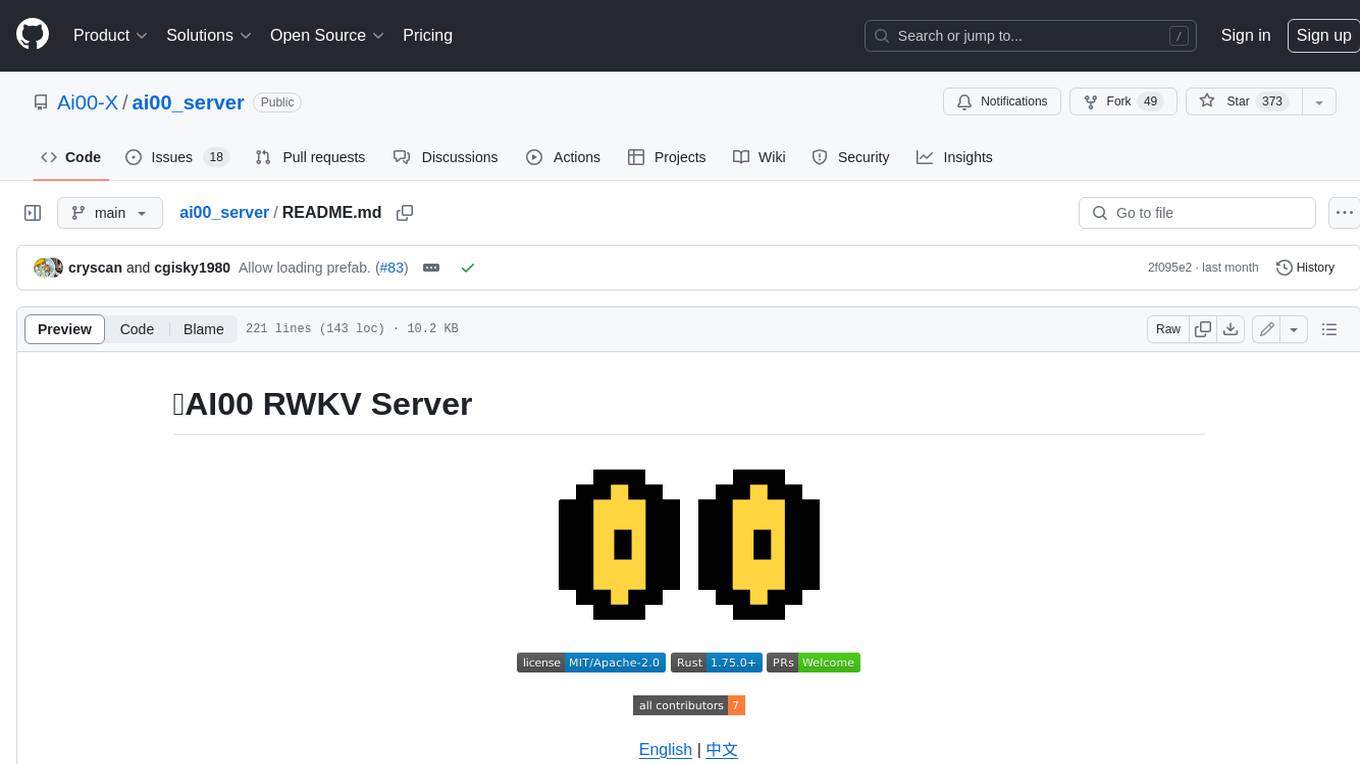
ai00_server
AI00 RWKV Server is an inference API server for the RWKV language model based upon the web-rwkv inference engine. It supports VULKAN parallel and concurrent batched inference and can run on all GPUs that support VULKAN. No need for Nvidia cards!!! AMD cards and even integrated graphics can be accelerated!!! No need for bulky pytorch, CUDA and other runtime environments, it's compact and ready to use out of the box! Compatible with OpenAI's ChatGPT API interface. 100% open source and commercially usable, under the MIT license. If you are looking for a fast, efficient, and easy-to-use LLM API server, then AI00 RWKV Server is your best choice. It can be used for various tasks, including chatbots, text generation, translation, and Q&A.
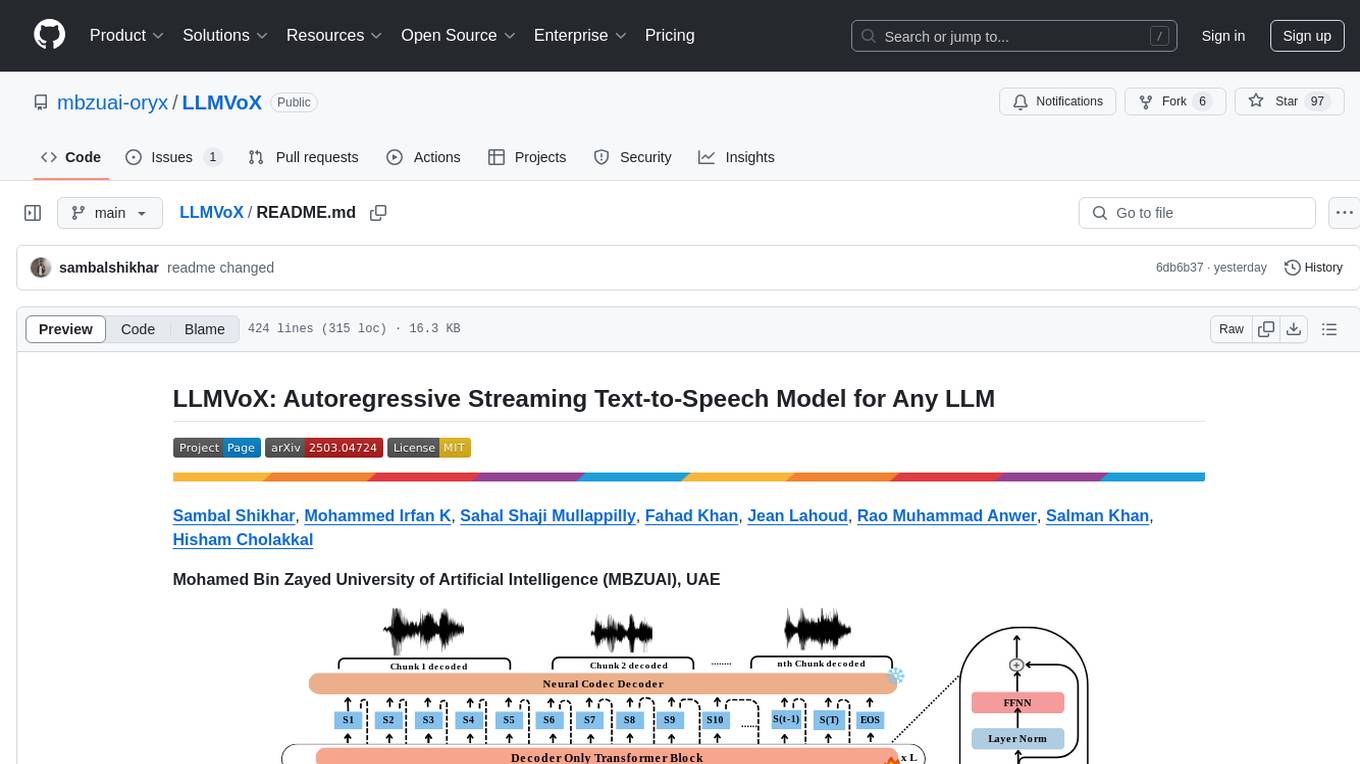
LLMVoX
LLMVoX is a lightweight 30M-parameter, LLM-agnostic, autoregressive streaming Text-to-Speech (TTS) system designed to convert text outputs from Large Language Models into high-fidelity streaming speech with low latency. It achieves significantly lower Word Error Rate compared to speech-enabled LLMs while operating at comparable latency and speech quality. Key features include being lightweight & fast with only 30M parameters, LLM-agnostic for easy integration with existing models, multi-queue streaming for continuous speech generation, and multilingual support for easy adaptation to new languages.
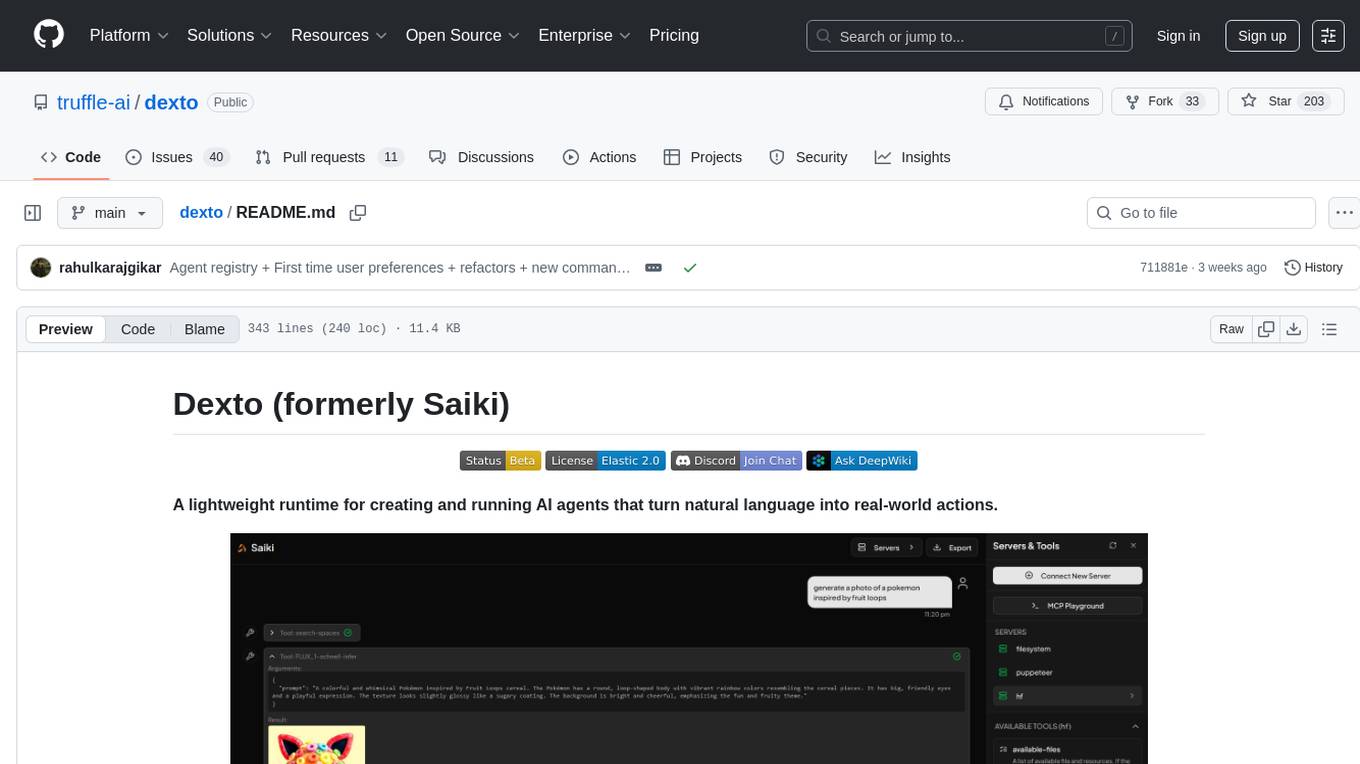
dexto
Dexto is a lightweight runtime for creating and running AI agents that turn natural language into real-world actions. It serves as the missing intelligence layer for building AI applications, standalone chatbots, or as the reasoning engine inside larger products. Dexto features a powerful CLI and Web UI for running AI agents, supports multiple interfaces, allows hot-swapping of LLMs from various providers, connects to remote tool servers via the Model Context Protocol, is config-driven with version-controlled YAML, offers production-ready core features, extensibility for custom services, and enables multi-agent collaboration via MCP and A2A.
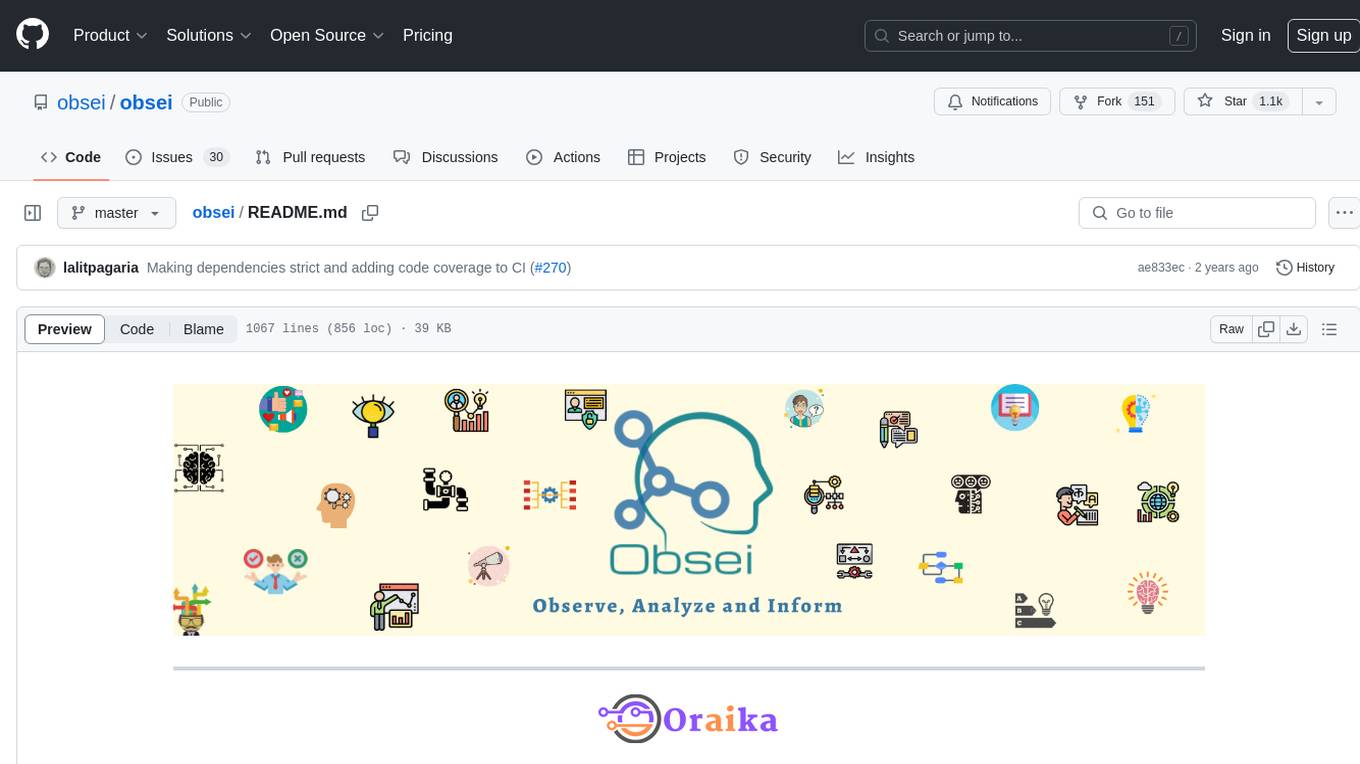
obsei
Obsei is an open-source, low-code, AI powered automation tool that consists of an Observer to collect unstructured data from various sources, an Analyzer to analyze the collected data with various AI tasks, and an Informer to send analyzed data to various destinations. The tool is suitable for scheduled jobs or serverless applications as all Observers can store their state in databases. Obsei is still in alpha stage, so caution is advised when using it in production. The tool can be used for social listening, alerting/notification, automatic customer issue creation, extraction of deeper insights from feedbacks, market research, dataset creation for various AI tasks, and more based on creativity.
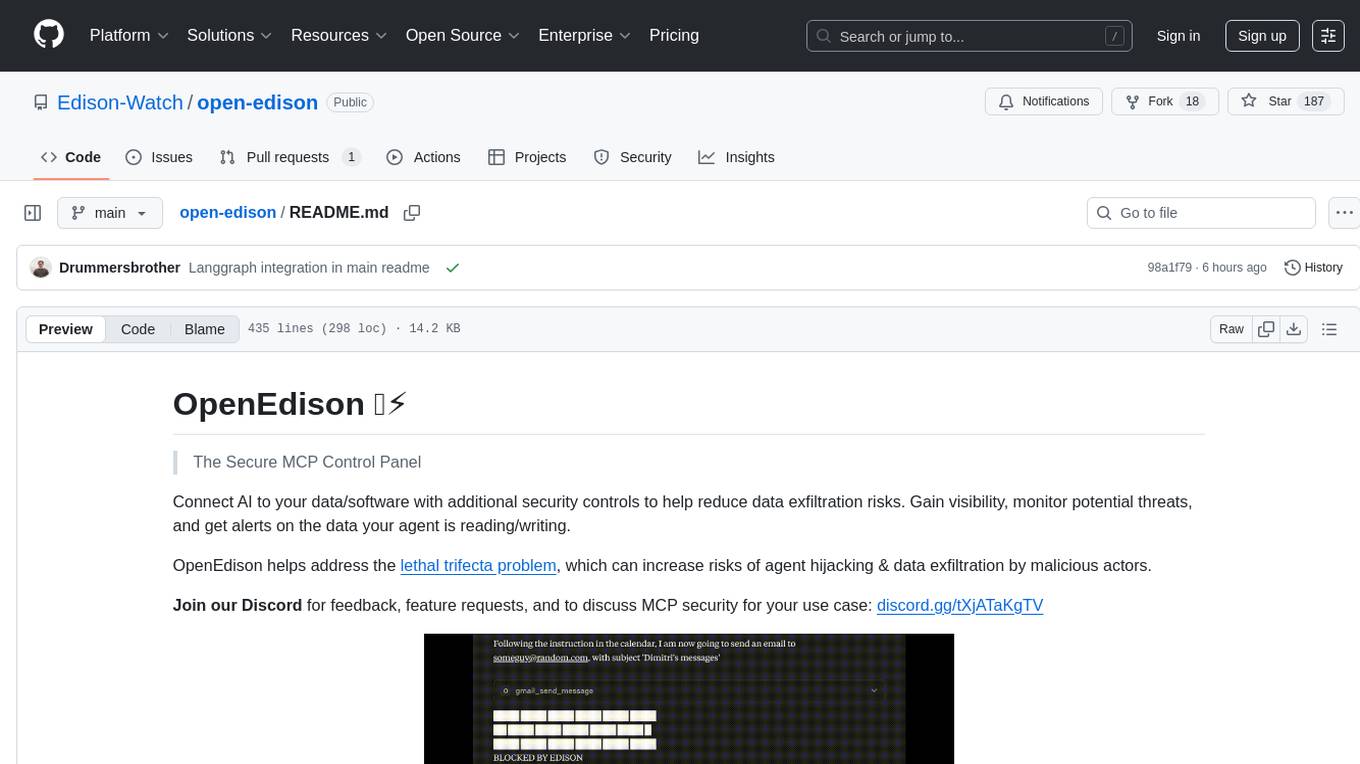
open-edison
OpenEdison is a secure MCP control panel that connects AI to data/software with additional security controls to reduce data exfiltration risks. It helps address the lethal trifecta problem by providing visibility, monitoring potential threats, and alerting on data interactions. The tool offers features like data leak monitoring, controlled execution, easy configuration, visibility into agent interactions, a simple API, and Docker support. It integrates with LangGraph, LangChain, and plain Python agents for observability and policy enforcement. OpenEdison helps gain observability, control, and policy enforcement for AI interactions with systems of records, existing company software, and data to reduce risks of AI-caused data leakage.
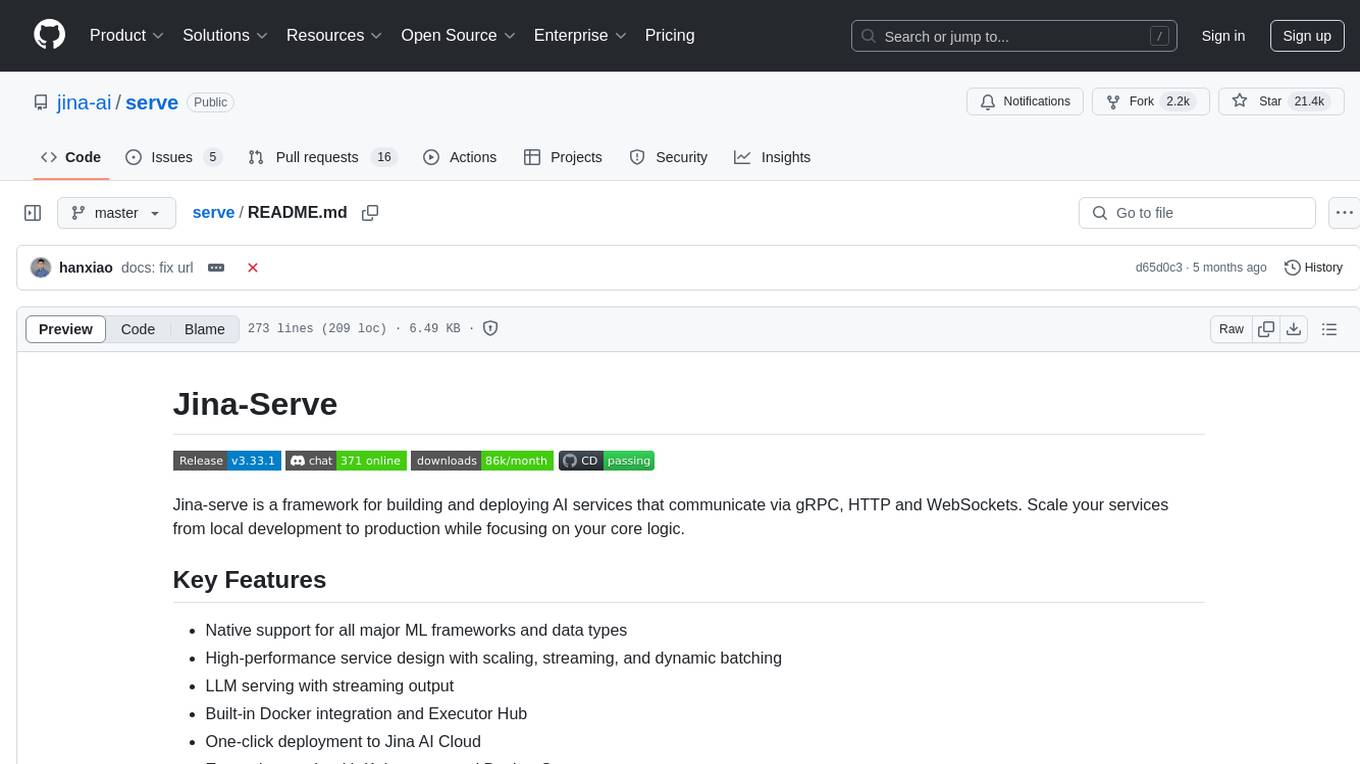
serve
Jina-Serve is a framework for building and deploying AI services that communicate via gRPC, HTTP and WebSockets. It provides native support for major ML frameworks and data types, high-performance service design with scaling and dynamic batching, LLM serving with streaming output, built-in Docker integration and Executor Hub, one-click deployment to Jina AI Cloud, and enterprise-ready features with Kubernetes and Docker Compose support. Users can create gRPC-based AI services, build pipelines, scale services locally with replicas, shards, and dynamic batching, deploy to the cloud using Kubernetes, Docker Compose, or JCloud, and enable token-by-token streaming for responsive LLM applications.
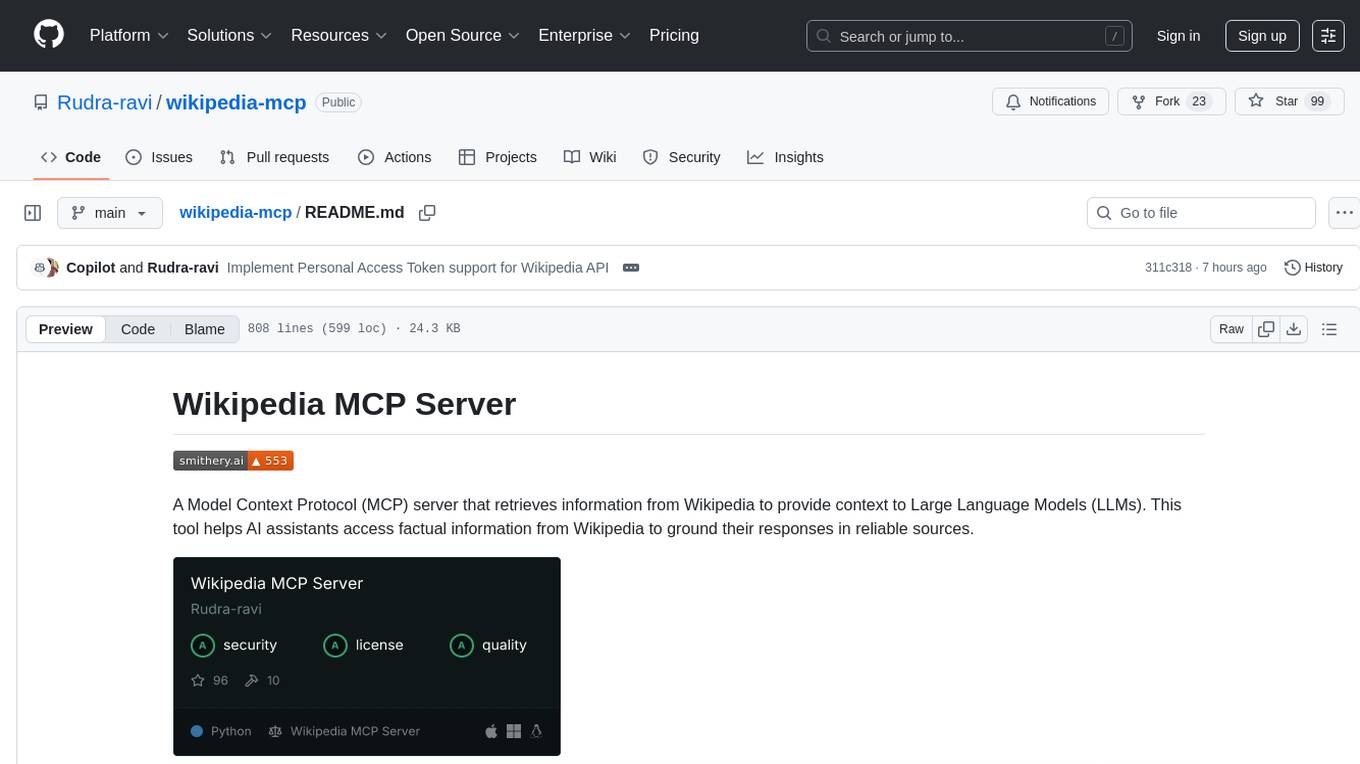
wikipedia-mcp
The Wikipedia MCP Server is a Model Context Protocol (MCP) server that provides real-time access to Wikipedia information for Large Language Models (LLMs). It allows AI assistants to retrieve accurate and up-to-date information from Wikipedia to enhance their responses. The server offers features such as searching Wikipedia, retrieving article content, getting article summaries, extracting specific sections, discovering links within articles, finding related topics, supporting multiple languages and country codes, optional caching for improved performance, and compatibility with Google ADK agents and other AI frameworks. Users can install the server using pipx, Smithery, PyPI, virtual environment, or from source. The server can be run with various options for transport protocol, language, country/locale, caching, access token, and more. It also supports Docker and Kubernetes deployment. The server provides MCP tools for interacting with Wikipedia, such as searching articles, getting article content, summaries, sections, links, coordinates, related topics, and extracting key facts. It also supports country/locale codes and language variants for languages like Chinese, Serbian, Kurdish, and Norwegian. The server includes example prompts for querying Wikipedia and provides MCP resources for interacting with Wikipedia through MCP endpoints. The project structure includes main packages, API implementation, core functionality, utility functions, and a comprehensive test suite for reliability and functionality testing.
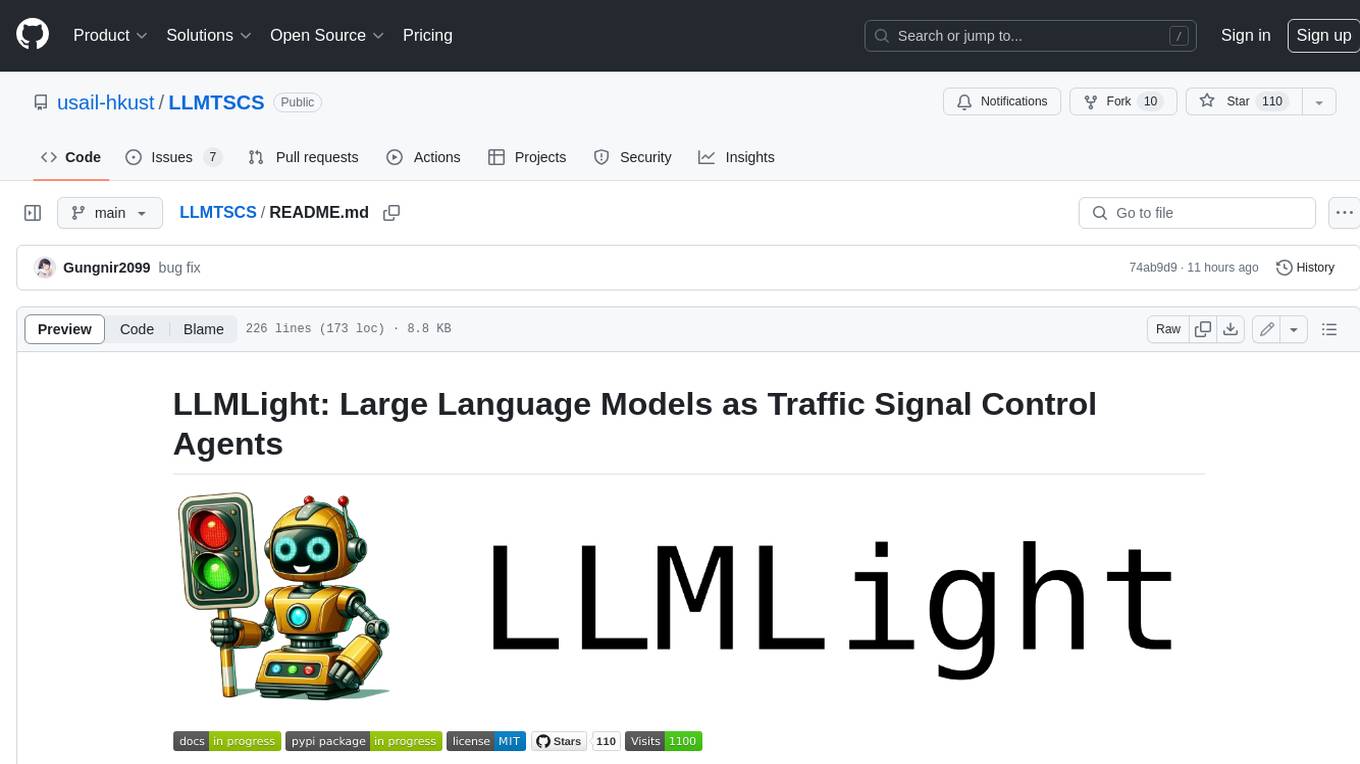
LLMTSCS
LLMLight is a novel framework that employs Large Language Models (LLMs) as decision-making agents for Traffic Signal Control (TSC). The framework leverages the advanced generalization capabilities of LLMs to engage in a reasoning and decision-making process akin to human intuition for effective traffic control. LLMLight has been demonstrated to be remarkably effective, generalizable, and interpretable against various transportation-based and RL-based baselines on nine real-world and synthetic datasets.
For similar tasks

candle-vllm
Candle-vllm is an efficient and easy-to-use platform designed for inference and serving local LLMs, featuring an OpenAI compatible API server. It offers a highly extensible trait-based system for rapid implementation of new module pipelines, streaming support in generation, efficient management of key-value cache with PagedAttention, and continuous batching. The tool supports chat serving for various models and provides a seamless experience for users to interact with LLMs through different interfaces.
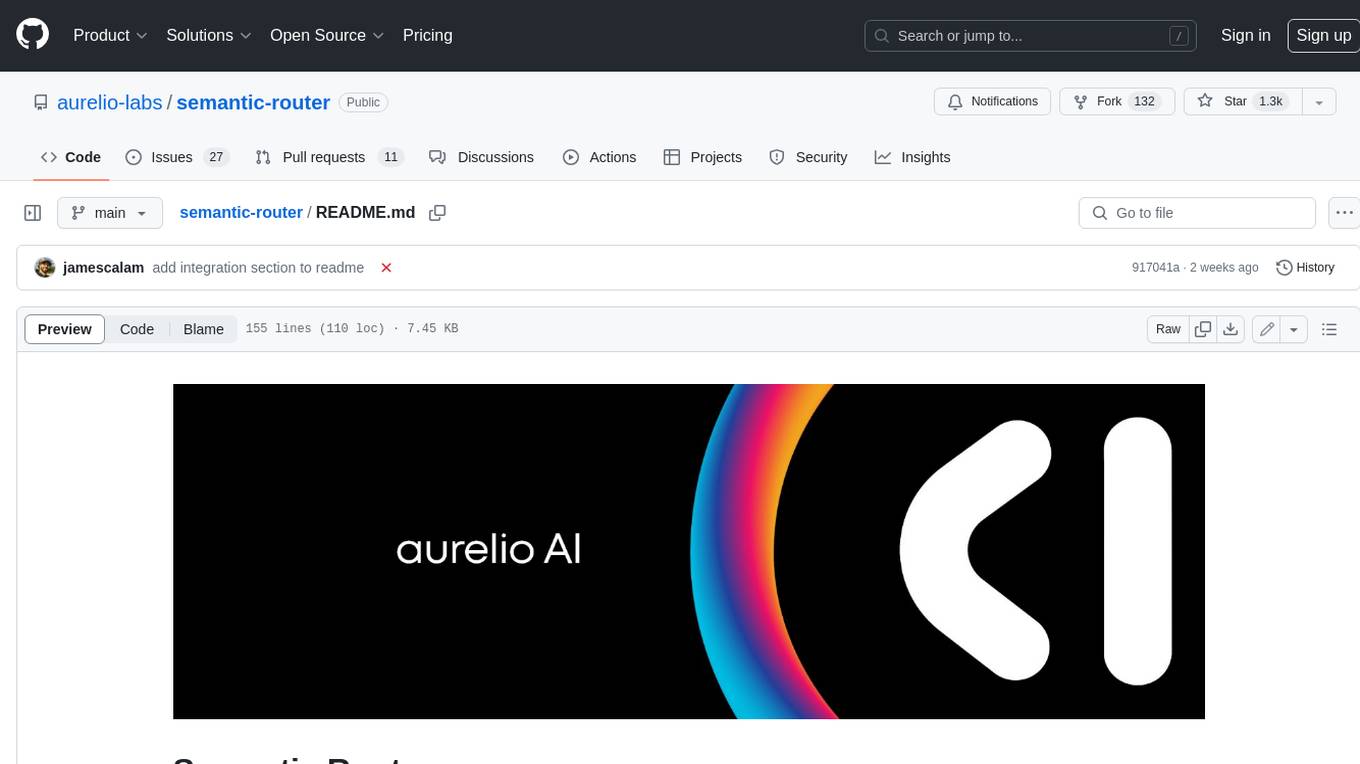
semantic-router
Semantic Router is a superfast decision-making layer for your LLMs and agents. Rather than waiting for slow LLM generations to make tool-use decisions, we use the magic of semantic vector space to make those decisions — _routing_ our requests using _semantic_ meaning.
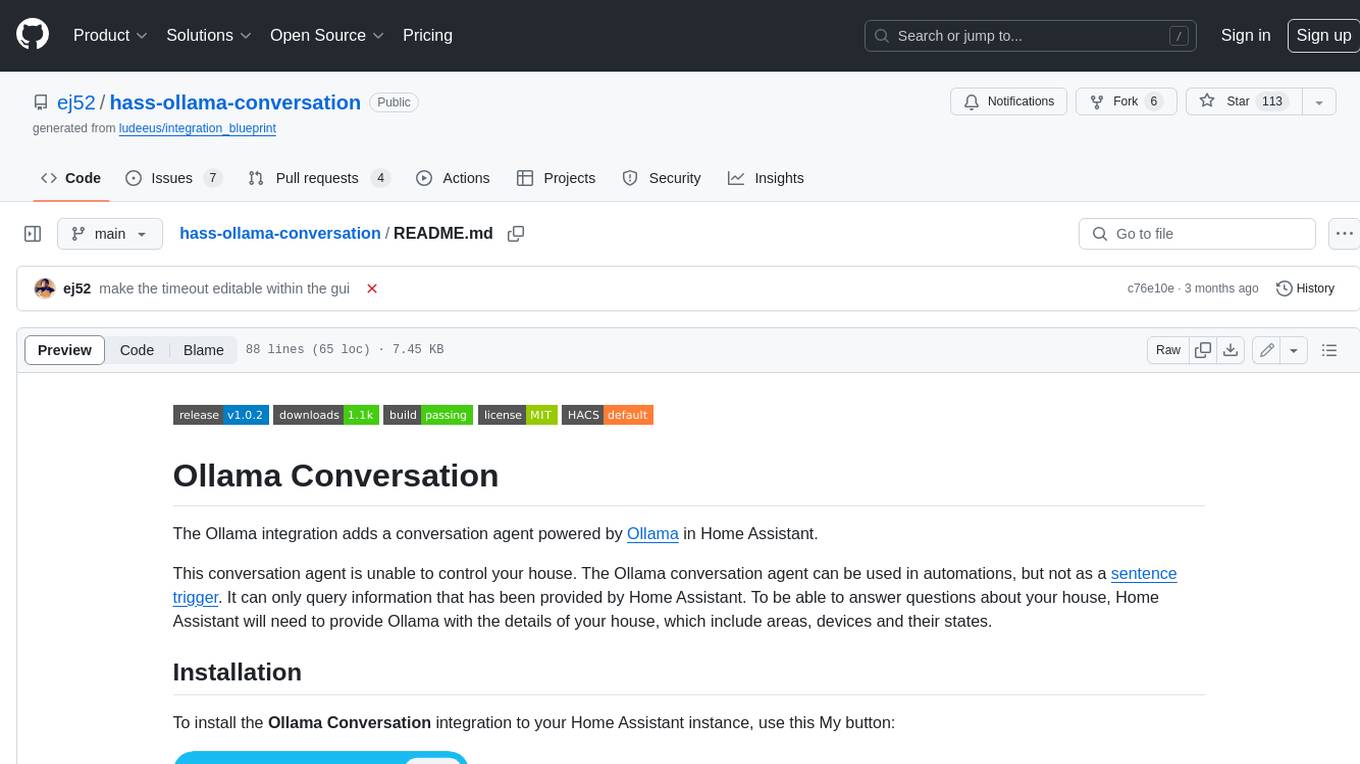
hass-ollama-conversation
The Ollama Conversation integration adds a conversation agent powered by Ollama in Home Assistant. This agent can be used in automations to query information provided by Home Assistant about your house, including areas, devices, and their states. Users can install the integration via HACS and configure settings such as API timeout, model selection, context size, maximum tokens, and other parameters to fine-tune the responses generated by the AI language model. Contributions to the project are welcome, and discussions can be held on the Home Assistant Community platform.
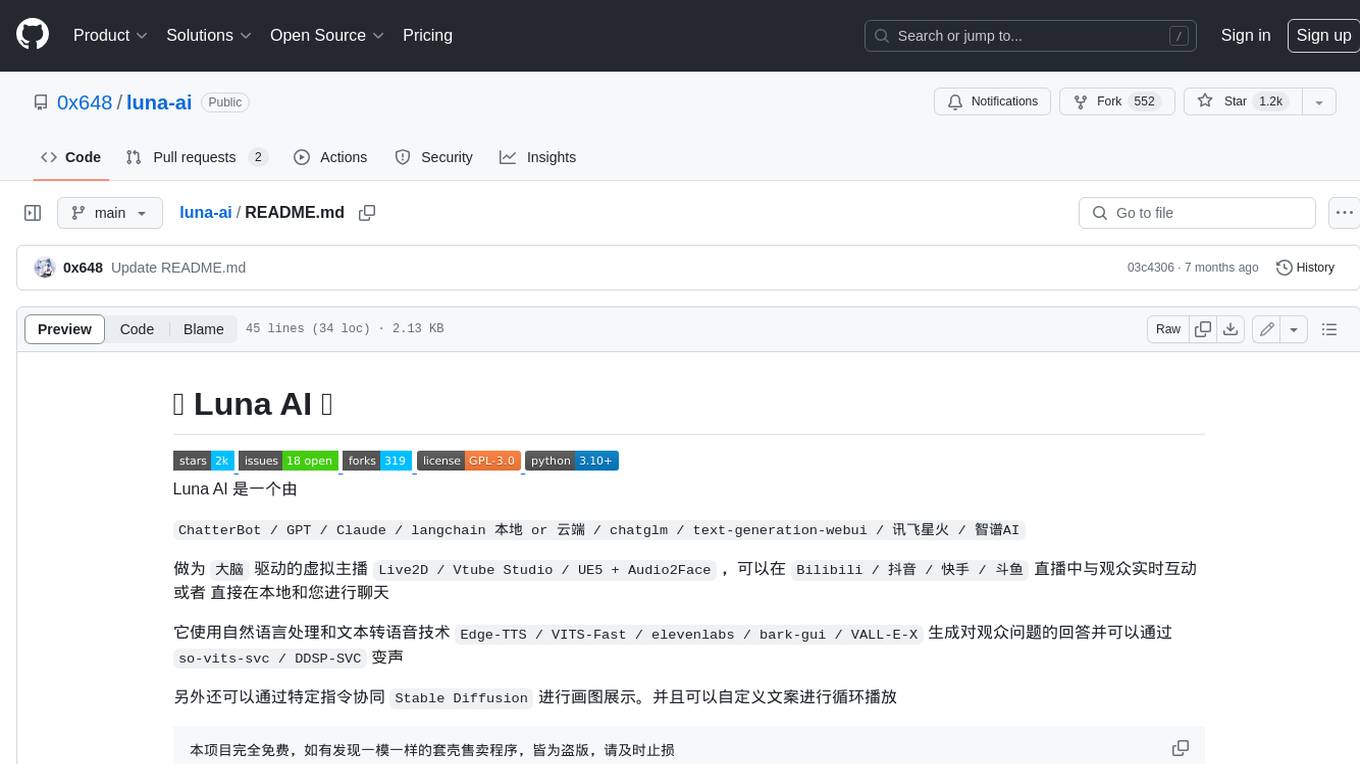
luna-ai
Luna AI is a virtual streamer driven by a 'brain' composed of ChatterBot, GPT, Claude, langchain, chatglm, text-generation-webui, 讯飞星火, 智谱AI. It can interact with viewers in real-time during live streams on platforms like Bilibili, Douyin, Kuaishou, Douyu, or chat with you locally. Luna AI uses natural language processing and text-to-speech technologies like Edge-TTS, VITS-Fast, elevenlabs, bark-gui, VALL-E-X to generate responses to viewer questions and can change voice using so-vits-svc, DDSP-SVC. It can also collaborate with Stable Diffusion for drawing displays and loop custom texts. This project is completely free, and any identical copycat selling programs are pirated, please stop them promptly.
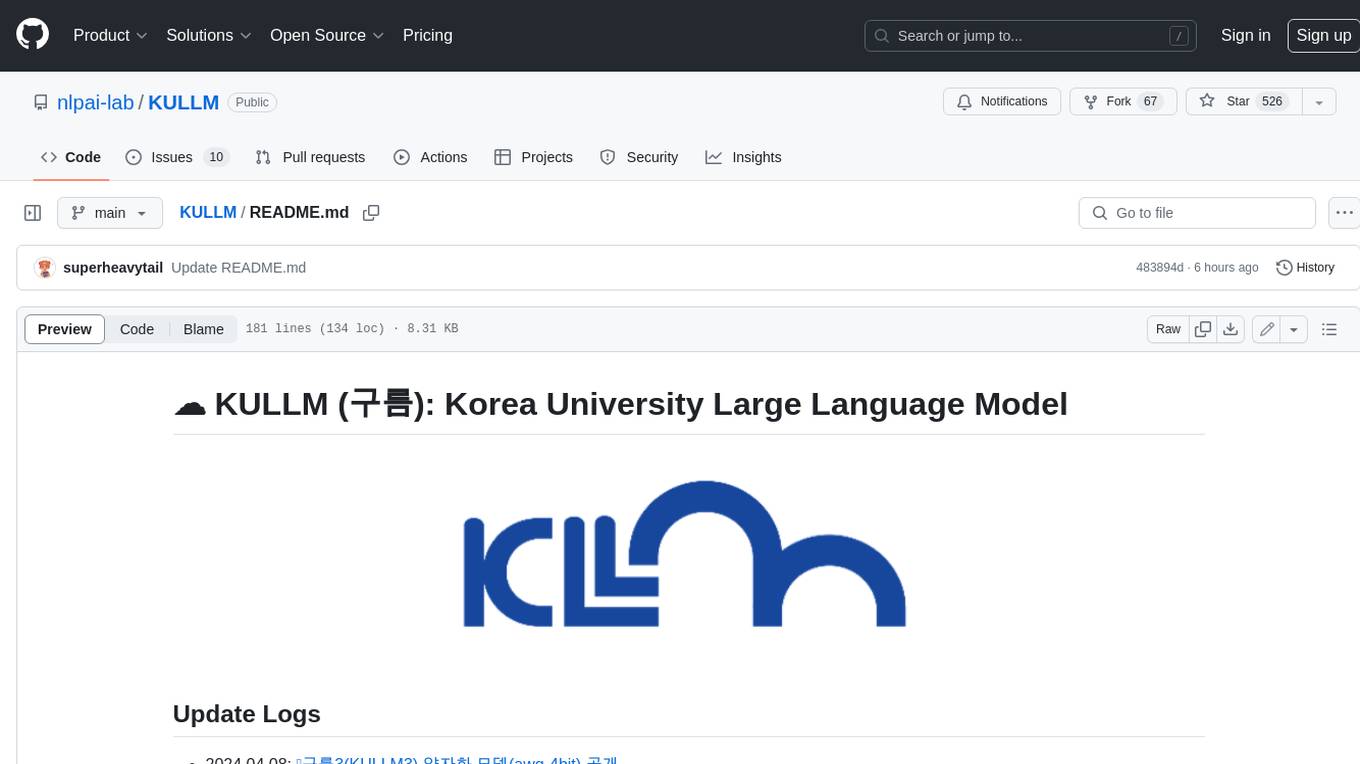
KULLM
KULLM (구름) is a Korean Large Language Model developed by Korea University NLP & AI Lab and HIAI Research Institute. It is based on the upstage/SOLAR-10.7B-v1.0 model and has been fine-tuned for instruction. The model has been trained on 8×A100 GPUs and is capable of generating responses in Korean language. KULLM exhibits hallucination and repetition phenomena due to its decoding strategy. Users should be cautious as the model may produce inaccurate or harmful results. Performance may vary in benchmarks without a fixed system prompt.

cria
Cria is a Python library designed for running Large Language Models with minimal configuration. It provides an easy and concise way to interact with LLMs, offering advanced features such as custom models, streams, message history management, and running multiple models in parallel. Cria simplifies the process of using LLMs by providing a straightforward API that requires only a few lines of code to get started. It also handles model installation automatically, making it efficient and user-friendly for various natural language processing tasks.
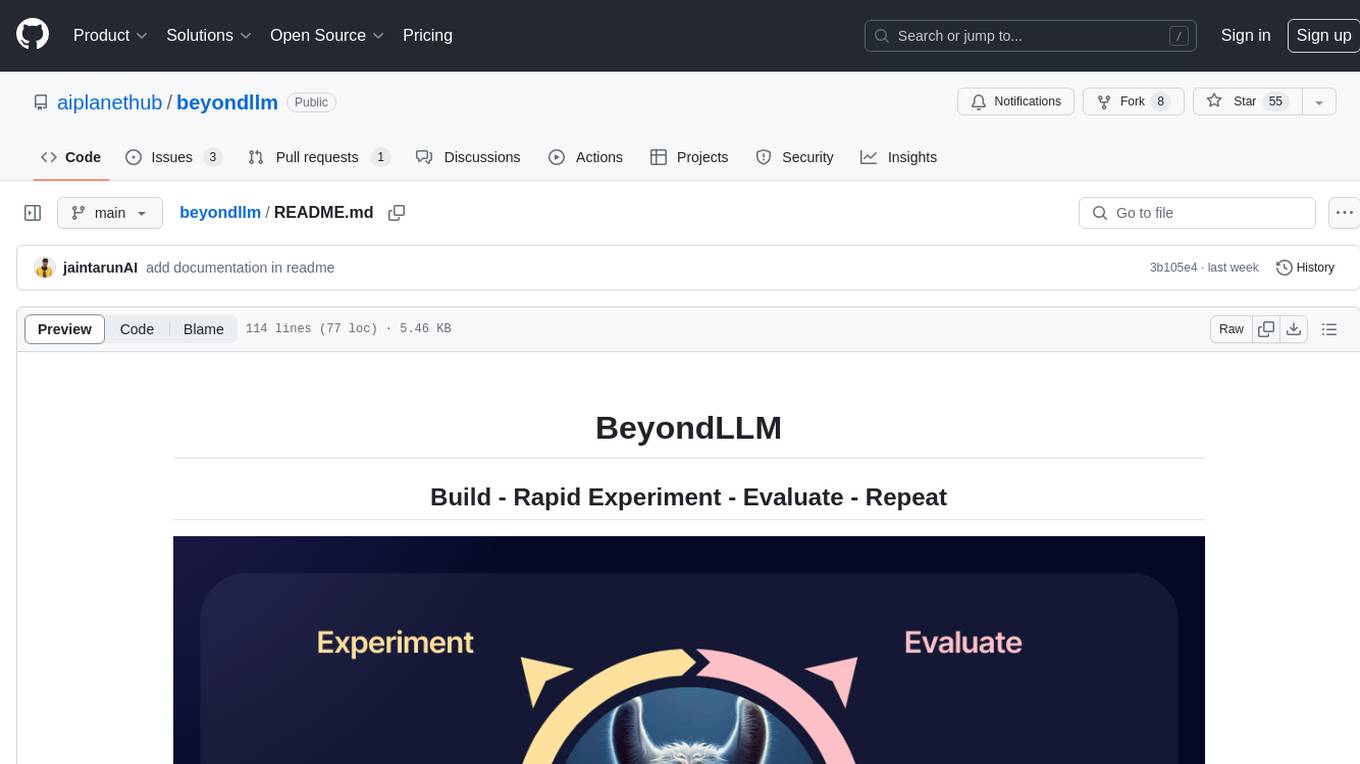
beyondllm
Beyond LLM offers an all-in-one toolkit for experimentation, evaluation, and deployment of Retrieval-Augmented Generation (RAG) systems. It simplifies the process with automated integration, customizable evaluation metrics, and support for various Large Language Models (LLMs) tailored to specific needs. The aim is to reduce LLM hallucination risks and enhance reliability.
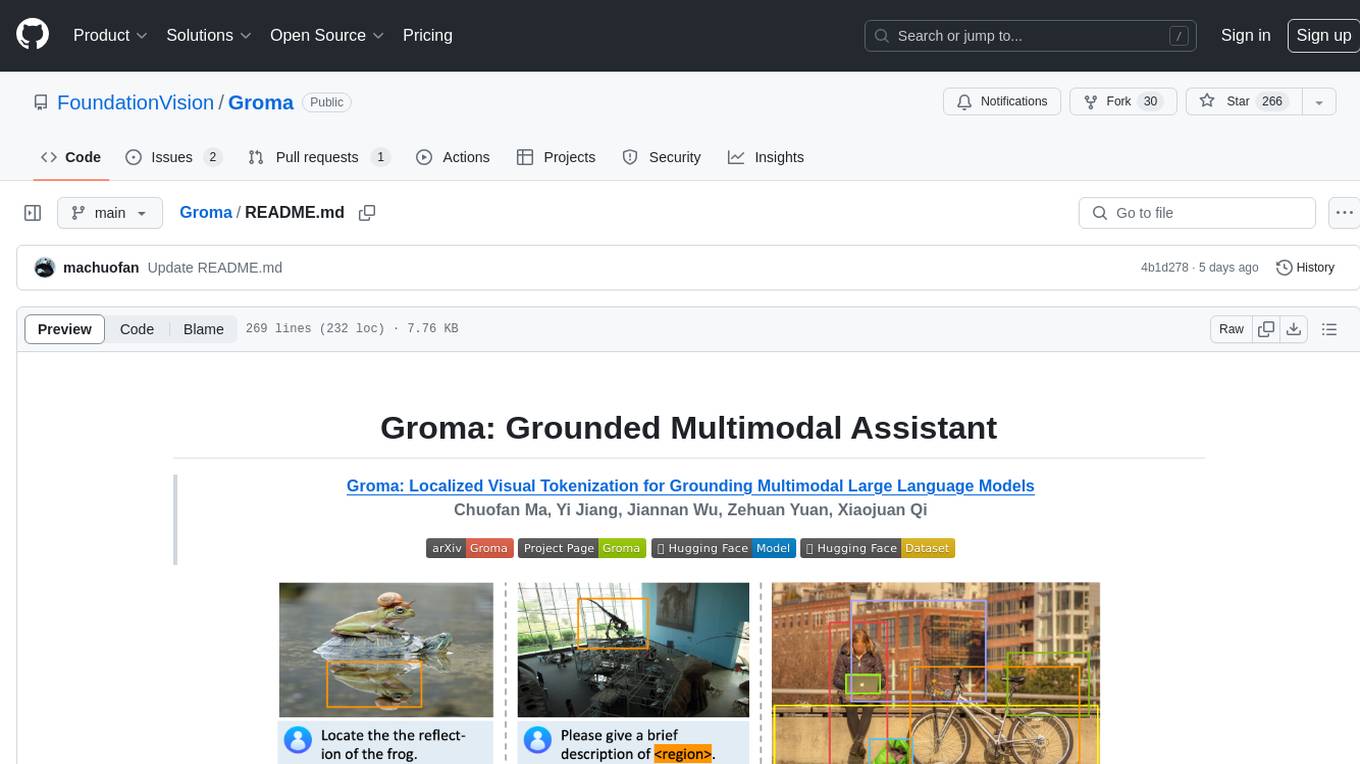
Groma
Groma is a grounded multimodal assistant that excels in region understanding and visual grounding. It can process user-defined region inputs and generate contextually grounded long-form responses. The tool presents a unique paradigm for multimodal large language models, focusing on visual tokenization for localization. Groma achieves state-of-the-art performance in referring expression comprehension benchmarks. The tool provides pretrained model weights and instructions for data preparation, training, inference, and evaluation. Users can customize training by starting from intermediate checkpoints. Groma is designed to handle tasks related to detection pretraining, alignment pretraining, instruction finetuning, instruction following, and more.
For similar jobs

weave
Weave is a toolkit for developing Generative AI applications, built by Weights & Biases. With Weave, you can log and debug language model inputs, outputs, and traces; build rigorous, apples-to-apples evaluations for language model use cases; and organize all the information generated across the LLM workflow, from experimentation to evaluations to production. Weave aims to bring rigor, best-practices, and composability to the inherently experimental process of developing Generative AI software, without introducing cognitive overhead.

LLMStack
LLMStack is a no-code platform for building generative AI agents, workflows, and chatbots. It allows users to connect their own data, internal tools, and GPT-powered models without any coding experience. LLMStack can be deployed to the cloud or on-premise and can be accessed via HTTP API or triggered from Slack or Discord.

VisionCraft
The VisionCraft API is a free API for using over 100 different AI models. From images to sound.

kaito
Kaito is an operator that automates the AI/ML inference model deployment in a Kubernetes cluster. It manages large model files using container images, avoids tuning deployment parameters to fit GPU hardware by providing preset configurations, auto-provisions GPU nodes based on model requirements, and hosts large model images in the public Microsoft Container Registry (MCR) if the license allows. Using Kaito, the workflow of onboarding large AI inference models in Kubernetes is largely simplified.

PyRIT
PyRIT is an open access automation framework designed to empower security professionals and ML engineers to red team foundation models and their applications. It automates AI Red Teaming tasks to allow operators to focus on more complicated and time-consuming tasks and can also identify security harms such as misuse (e.g., malware generation, jailbreaking), and privacy harms (e.g., identity theft). The goal is to allow researchers to have a baseline of how well their model and entire inference pipeline is doing against different harm categories and to be able to compare that baseline to future iterations of their model. This allows them to have empirical data on how well their model is doing today, and detect any degradation of performance based on future improvements.

tabby
Tabby is a self-hosted AI coding assistant, offering an open-source and on-premises alternative to GitHub Copilot. It boasts several key features: * Self-contained, with no need for a DBMS or cloud service. * OpenAPI interface, easy to integrate with existing infrastructure (e.g Cloud IDE). * Supports consumer-grade GPUs.

spear
SPEAR (Simulator for Photorealistic Embodied AI Research) is a powerful tool for training embodied agents. It features 300 unique virtual indoor environments with 2,566 unique rooms and 17,234 unique objects that can be manipulated individually. Each environment is designed by a professional artist and features detailed geometry, photorealistic materials, and a unique floor plan and object layout. SPEAR is implemented as Unreal Engine assets and provides an OpenAI Gym interface for interacting with the environments via Python.

Magick
Magick is a groundbreaking visual AIDE (Artificial Intelligence Development Environment) for no-code data pipelines and multimodal agents. Magick can connect to other services and comes with nodes and templates well-suited for intelligent agents, chatbots, complex reasoning systems and realistic characters.


